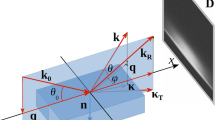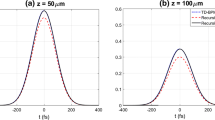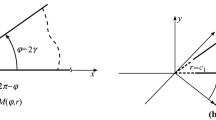Abstract
The recursive transfer method (RTM) provides a unique numerical means of extracting a localised wave in a scattering problem. However, various shapes of scatterers were hitherto difficult to adapt RTM, because mesh elements were limited to rectangles. In this study, we propose what we call mechanics shape function using subdivision triangles of a quadrilateral element, and we extend RTM to be valid for various shapes of scatterers. The effect of the mechanics shape function is evaluated using a uniform waveguide with a distorted mesh.





Similar content being viewed by others
References
Antonakakis, T., Craster, R.V., Guenneau, S.: Moulding and shielding flexural waves in elastic plates. Europhys. Lett. 105 (2014). doi:10.1209/0295-5075/105/54004
Farhat, M., Guenneau, S., Enoch, S., Movchan, A.B.: Cloaking bending waves propagating in thin elastic plates. Phys. Rev. B 79 (2009). doi:10.1103/PhysRevB.79.033102
Yamanouchi, K. (ed.): Elastic device technology. Japan Academic Society 150-th committee of elastic device technology. Ohmsha, Tokyo (2004)
Royer, D., Dieulesaint, E.: Elastic Waves in Solids II: Generation, Acousto-optic Interaction, Applications, Chap. 5. Springer, Berlin (2000)
Haslinger, S.G., Movchan, A.B., Movchan, N.V., McPhedran, R.C.: Symmetry and resonant modes in platonic grating stacks. Waves Random Complex Media 24, 126–148 (2014)
Brebbia, C.A., Connor, J.J.: Fundamentals of Finite Element Techniques for Structural Engineers. Butterworths, London (1973)
Zienkiewicz, O.C., Taylor, R.L.: The finite element method, volume2: Solid and fluid mechanics dynamics and non-linearity, Forth edn. McGrawHill, London (1989)
Kato, H., Kato, H.: An application of recursive transfer method to flexural waves I: A discretisation scheme using weak form theory and waveguide modes on inhomogeneous static plates. IEICE Trans. E97-A, 1075–1085 (2014)
Kato, H., Kato, H.: An application of recursive transfer method to flexural waves II: Reflection enhancement caused by resonant scattering in acoustic waveguide. IEICE Trans. E98-A, 354–361 (2015)
Kato, H., Kato, H.: Weak-form discretization scheme for recursive transfer method and discretization errors. Trans. JSIAM 25, 31–46 (2015)
Kato, H., Kato, H.: Accuracy of weak-form discretisation and extension of recursive transfer method for scattering problems governed by fourth-order differential equation. J. Phys. Soc. Jpn. 85 (2016). doi:10.7566/JPSJ.85.054001
Appelbaum, J.A., Hamann, D.R.: Self-consistent electronic structure of solid surfaces. Phys. Rev. B 6, 2166–2177 (1972)
Hirose, K., Tsukada, M.: First-principles calculation of the electronic structure for a dielectrode junction system under strong field and current. Phys. Rev. B 51, 5278–5290 (1995)
Kato, H., Kanno, Y.: An analysis on microwave absorption of the catalyst in a thermal decomposition reaction by the recursive transfer method. Jpn. J. Appl. Phys. 47, 4846–4850 (2008)
Kato, H., Kato, H.: New numerical method of scattering problems using recursive transfer method under the weak-form discretization scheme. In: Proceedng of the 44-th Numerical Analysis Symposioum. Katsunuma, pp. 1–4 (2015)
Kato, H., Kato, H.: Weak-form discretisation, waveguide boundary conditions and extraction of quasi-localized waves causing Fano resonance. IEICE Trans. E97–A, 1720–1727 (2014)
Šolín, P.: Partial Differential Equations and the Finite Element Method. Wiley, Hoboken (2006)
Chen, W., Fu, Z.J., Chen, C.S.: Recent Advances in Radial Basis Function Collocation Methods. Springer, Heidelberg (2014)
Strouboulis, T., Babuška, I., Copps, K.: The design and analysis of the Generalized Finite Element Method. Comput. Methods Appl. Mech. Eng. 181, 43–69 (2000)
Kato, H., Kato, H.: A novel formulation of flexural waves on inhomogeneous elastic plates using tensor basis. Trans. JSIAM 22, 253–267 (2012)
Bobrovnitskii, YuI: Calculation of the power flow in flexural waves on thin plates. J. Sound Vib. 149, 103–106 (1996)
Author information
Authors and Affiliations
Corresponding author
Additional information
This research is supported by JSPS KAKENHI (15K04752).
Appendices
Appendix A: Vanising of the flux divergence
Expressing the time derivative of the field as \(\dot{u}\), the energy flux \(\mathbf{J}\) was defined as \(\mathbf{J} = \sum _{r=0}^2\big \{ \dot{u} \varDelta _r ( D_r \varDelta _r u) ) - \nabla \dot{u} \cdot \hat{\gamma }_r D_r (\varDelta _r u) \big \}\) [8, 21] Because the deformation \(u(\mathbf r)\) satisfies (5), we can express the divergence of the flux as \( \nabla \cdot \mathbf{J} = -q(\dot{u},u)\), where \(q(\dot{u},u)\) is the spurious energy generation defined by (3). Assuming that the field is in a steady state and expressed in a complex representation, the integral of the flux about the subdivision region \(S^{(n,e)}\) can be transformed as follows:
where ‘*’ denotes the complex conjugate. Using the interpolation expression (31), the expression on the right-hand side in (40) can be discretised to derive the following expression:
According to (41), the divergence definitely vanishes in the discretised system for any complex fields \(\mathbf{U}^{(n,e)}\), because the matrix \(\tilde{f}_\mathrm{mch}^{(n,e)}(\mathbf{r})\) is symmetric.
Appendix B: Cubic Hermite element for a rhombus
A conventional shape function, that is valid in a rhombus element and compatible with the weak-form discretisation for RTM, can consist of the direct product of the one-dimensional cubic polynomials of a Hermite element. Two fundamental shape functions in a one-dimensional space have the form as \(\ell (\xi ) = 1-3\xi ^2 + 2\xi ^3\) and \(n(\xi ) = \xi (1-\xi )^2\) [17] for \(0 \le \xi \le 1\). Three elementary functions for the first vertex at \((\xi , \eta ) = (0, 0)\) can be created by direct products as follows:
Using a column vector \(\mathbf{h}_\mathrm{lcl}^{(1)}(\xi ,\eta )\) = \([{\ } L_\mathrm{H}^{(1)}(\xi ,\eta ){\ }\) \(L_{\mathrm{H},\xi }(\xi ,\eta ){\ }\) \(L_{\mathrm{H},\eta }(\xi ,\eta ){\ } ]^T\) a set of shape functions for the other vertices can be defined as follows: \(\mathbf{h}_\mathrm{lcl}^{(2)}(\xi ,\eta ) = \mathbf{h}_\mathrm{lcl}^{(1)}(1-\xi ,\eta )\), \(\mathbf{h}_\mathrm{lcl}^{(3)}(\xi ,\eta ) = \mathbf{h}_\mathrm{lcl}^{(1)}(1-\xi ,1-\eta )\) and \(\mathbf{h}_\mathrm{lcl}^{(4)}(\xi ,\eta ) = \mathbf{h}_\mathrm{lcl}^{(1)}(\xi ,1-\eta )\). For transforming the local coordinate \((\xi ,\eta )\) to the global position vector \(\mathbf{r}\), the relation (12) was used provided that p = 1. Using the transformation matrix \(m_q^{(n,e)}\) that is defined by (17), the directional derivatives in \(\mathbf{h}_\mathrm{lcl}^{(q)}(\xi ,\eta )\) can be transformed into the derivatives with respect to x and y from \(\xi \) and \(\eta \) as follows:
where q = 1, 2,..., \(P^{(n,e)}\).
A \(3P^{(n,e)}\)-dimensional row vector, \(\mathbf{L}(\mathbf{r}) \), that is composed of the shape functions can be defined as follows:
Then, the field \(u(\mathbf{r})\) can be interpolated with the \(3P^{(n,e)}\)-dimensional column vector \(\mathbf{U}^{(n,e)}\) of the vertex field, that was defined in Sect. 3.2, as follows:
which is valid in rhombus elements.
The Hermite shape function can be extended to a scalene rhombus or quadrilateral. In this case, the mapping from the \(\xi \eta \)-plane to the xy-plane is no longer linear, and the Jacobian depends on \(\xi \) and \(\eta \); therefore, the integrands in the expressions (24) and (25) become rational functions of \(\xi \) and \(\eta \), and the analytic expressions of the integrals cannot be derived by symbolic formula manipulation. The integrals can be obtained using numerical methods, but the calculation efficiency and accuracy are significantly degraded. In contrast, the mechanics shape function has no such problems because the Jacobian is constant as discussed in Sect. 3.1.1.
About this article
Cite this article
Kato, H., Kato, H. & Naito, Y. Mechanics shape function of quadrilateral element composed of subdivision triangles for recursive transfer method. Japan J. Indust. Appl. Math. 35, 277–295 (2018). https://doi.org/10.1007/s13160-017-0281-9
Received:
Revised:
Published:
Issue Date:
DOI: https://doi.org/10.1007/s13160-017-0281-9
Keywords
- Recursive transfer method (RTM)
- Mechanics shape function
- Weak-form discretisation
- Biharmonic wave
- Flexural wave




